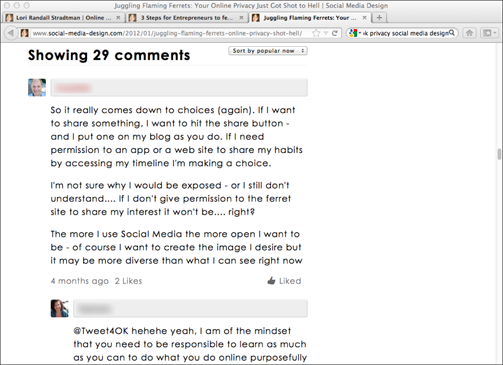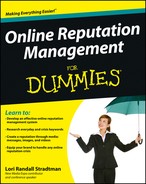Figure 17-1: Blog comments with Facebook “Like” enabled.
Making Personal Connections
Doing well in the online world requires more than being charitable. Sure, you can publish free tutorials, upload funny videos, or distribute rebates or coupons, but people won’t necessarily appreciate you for it. After all, people tend to distrust strangers. If you’re giving away something for free, people will naturally question your motives. They’ll assume you’re going to ask them for something in return.
This is why it’s critical for you to make personal connections online. When people feel that they have a good sense about who you are and what you’re about, they’ll have less reason to be suspicious about you. You become a friend. And the next time you offer something online, odds are good that the people you’ve befriended will respond positively.
It’s important for you to be upfront about
![]() Who you are
Who you are
![]() What you do
What you do
![]() Whom you do it for
Whom you do it for
![]() What you expect to receive in return
What you expect to receive in return
Long-term emotional connections are the key to developing these kinds of relationships. I want you to cultivate a few different categories of personal connections online, and in this section, I show you how to explore them.
Developing connections with bloggers
The fastest and easiest way to connect personally with any blogger who is a thought leader in your industry is to read and comment on his posts. When you’re a blogger, there’s nothing quite as satisfying as getting lots of informed, insightful comments on posts you’ve researched and crafted with love. The more consistently you contribute to the discussion by commenting and sharing, the more likely somebody is to respond to you either in his blog or on a social network. You can begin to establish a rapport at a pace that feels comfortable to you both. Figure 17-1 shows some comments on a WordPress blog, complete with social media–sharing enabled. It’s never been easier to spread your message like wildfire online.
Sometimes well-known bloggers in your area of expertise just don’t have the time and space to include new people into their lives. I’m not the biggest new media and design blogger you’ll ever meet, but I really make the effort to get to know people who reach out to me in a way that’s comfortable to me online.

Developing connections with social media users
I try to always be positive and give you examples of something to do, but sometimes it’s useful to look at what not to do in order to understand what makes sense. Just in case you are brand new to Twitter, Facebook, LinkedIn, and other social networks, here are a few activities to avoid using very often to reach out, unless you’re engaging in a dialogue. I’ll be surprised if you haven’t seen somebody either overuse one of these terrific tools or indulge in one of the following relationship inhibitors. I show you which of the following are useful tools when used judiciously and which ones can put a strain on your relationships unless you already know the person you’re contacting very well.
![]() Direct messaging on Twitter (tool)
Direct messaging on Twitter (tool)
![]() Private messaging (tool)
Private messaging (tool)
![]() Initiating chats via any backchannel, such as Facebook chat (tool)
Initiating chats via any backchannel, such as Facebook chat (tool)
![]() E-mails asking for free products or services (probable relationship inhibitor)
E-mails asking for free products or services (probable relationship inhibitor)
![]() Asking for “just a few minutes” of service (probable relationship inhibitor)
Asking for “just a few minutes” of service (probable relationship inhibitor)
![]() Being confrontational just for attention (probable relationship inhibitor)
Being confrontational just for attention (probable relationship inhibitor)
![]() Hijacking a conversation thread with one’s own agenda (probable relationship inhibitor)
Hijacking a conversation thread with one’s own agenda (probable relationship inhibitor)
![]() Asking to use the other person’s platform to post links and so forth (probable relationship inhibitor)
Asking to use the other person’s platform to post links and so forth (probable relationship inhibitor)
![]() Posting links without even asking (probable relationship inhibitor)
Posting links without even asking (probable relationship inhibitor)
I bet you can add to this list with activities you’ve seen or experienced.
Developing relationships with clients
Hopefully, when you take your business online, you maintain a personal kind of connection with your past and present clients, and also build such a connection with future clients. The easiest way to do this is by providing them with a product or service that makes their lives better in a demonstrable way.
This is one of the easiest kinds of personal connections to maintain, because your clients already believe in you and in your business. Here are a few proven ways to keep up with your clients and continue to show them that they are special to you, that they rate a higher standard of TLC than someone who has never done business with you before:
![]() Send them updates about your business or organization in e-mail newsletters. If you decide you want to publish an e-mail newsletter, I suggest you use it to help your audience with valuable, relevant content such as
Send them updates about your business or organization in e-mail newsletters. If you decide you want to publish an e-mail newsletter, I suggest you use it to help your audience with valuable, relevant content such as
• Maintenance tips: For example, if you own a knitting-related brand, you can show people how to maintain (and store) different kinds of knitting needles. If the article’s going to be long or involve more than a couple pictures, you can link to a blog post. This drives more traffic to your site and saves your newsletter subscribers from having large e-mail files cluttering up their computers.
• Industry news: Share the latest and greatest news trends for your industry. For example, if you have a knitting-related brand, you can make a big splash with Yak yarns, should they ever develop, by telling all about how they’re made, what to do with them, and linking to Yak yarn patterns.
 These days, there is a lot of talk about using e-mail newsletters to sell stuff for other people in exchange for including you on their e-mail lists when you release a product.
These days, there is a lot of talk about using e-mail newsletters to sell stuff for other people in exchange for including you on their e-mail lists when you release a product.
This is all good fun until somebody gets hurt. When someone else’s product doesn’t measure up and you’ve pitched it to your e-mail subscribers, many of whom are your strongest brand advocates, you’ll be the one getting hurt. I don’t want that to be you or your clients.
Carefully consider what offers you will share and guard the people on your list jealously. Signing up for an e-mail newsletter is a sacred trust with most people, and trust is really all you have when it comes to your reputation online. Take the high road and use your newsletter to do good in the world, make an occasional sale, and guard the privacy of your subscribers. They will love you for it.
![]() When you’re preparing a special promotion, send your clients invitations to participate in the promotion before anybody else. Invitations can include
When you’re preparing a special promotion, send your clients invitations to participate in the promotion before anybody else. Invitations can include
• Reduced pricing
• First crack at special features, such as a beta version of a software application you’ve been developing
![]() Send your clients occasional bonus products or services, just because these people have been your clients.
Send your clients occasional bonus products or services, just because these people have been your clients.
Developing relationships with fans
When you reach out to make personal connections with fans, both old and new, keep in mind that going after demographics such as age or gender isn’t going to get you nearly as far as looking at psychographics. (See Chapter 8 for more on psychographics.) Basically, psychographics refers to groups of people who share the same kind of thinking about a subject or product.
For example, if your company sells glow-in-the-dark Chia pets, your research may reveal that the people most interested in your products are people who are also interested in topics as diverse as
![]() Organic food
Organic food
![]() Home decor
Home decor
![]() Delightfully tacky retro stuff
Delightfully tacky retro stuff
![]() Gag gifts
Gag gifts
When you know these groups of people constitute your fan base, it’s a great idea to go where they hang out online and connect with them in those places. Be a fan anthropologist: Contact your fans. Have fun with them. Let them know who you are and why you do what you do. Study their languages and the way they refer to your products or similar products, and learn to respond in kind. And always treat them with respect.

